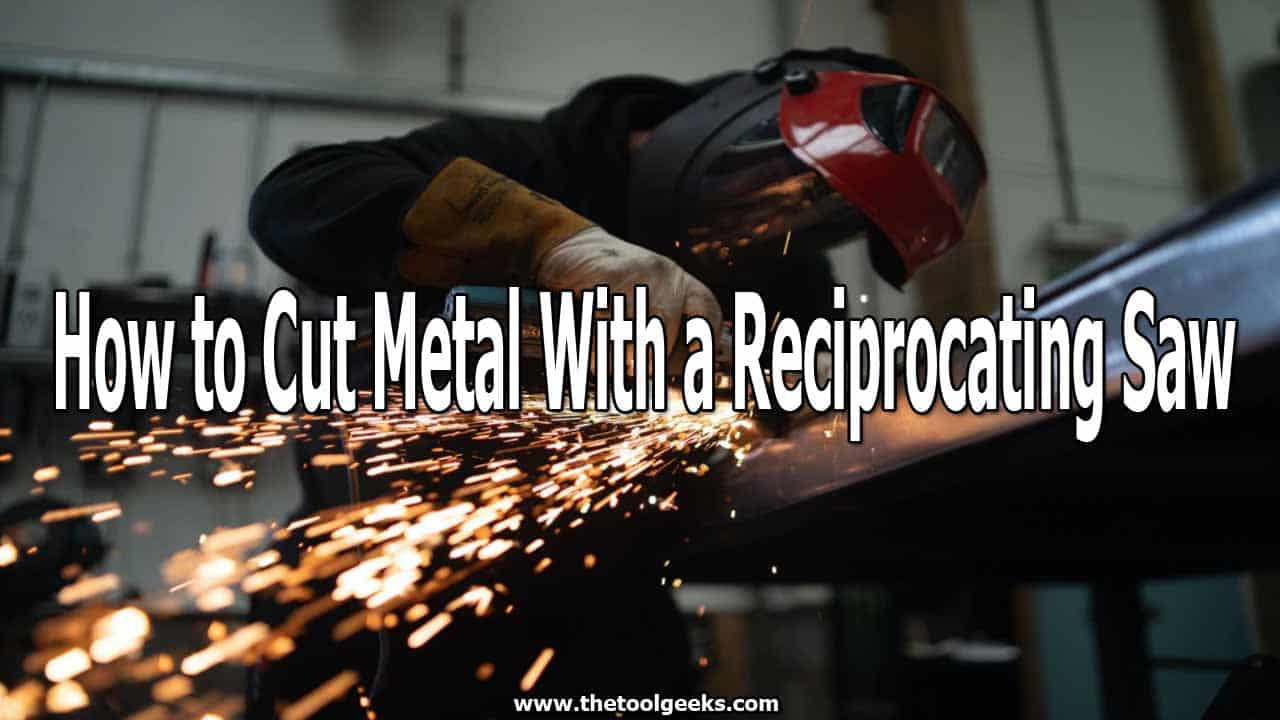How to Cut Metal With a Reciprocating Saw (11 Steps Included)
TheToolGeeks.com is a participant in the Amazon Services LLC Associates Program and other affiliate advertising programs. We may earn from qualifying purchases. (Learn More).
Remodeling and demolition projects can be very tedious if you don’t have the right tools. Especially when you’re cutting through tougher materials like metal.
How can you cut the time and effort without hiring another pair of hands?
We’ll tell you how and give you some ingenious tips too!
All you must do is sit back and read this post till the end. Now without further ado, let’s get started.
Jump To Page Contents:
How can I cut metal faster?
The best way to cut metals faster is to use power tools. Now you can use a hacksaw and finish a small job in a week and lose weight in the meantime.
But there are better weight loss techniques and a quicker way to cut through metals. We’ll be talking about the latter.
You can use either a reciprocating saw or an angle grinder to speed up the process. However, for DIYers, we recommend using a reciprocating saw.
Why?
Because of its ability to cut in confined spaces and faster learning curve. Don’t know what a reciprocating saw is?
Let’s see what it is.
What is a Reciprocating Saw?
A reciprocating saw is a machine-powered saw that operates using a push-and-pull motion of the blade. It will cost you around $1xx to $3xx based on the brand and model you pick and is compatible with different attachments.
A reciprocating saw cuts through most materials but is not recommended for thicker metals. We have reviewed reciprocating saws — read the review here.
Unlike angle grinders, the blade of reciprocating saws is exposed allowing them to reach tight spaces. So, if you’ve got a project that needs to be completed in a small area, a reciprocating saw should be your go-to tool. Many of these power tools also feature a perpendicular oscillating setting that lets you complete an oval cutting motion.
We don’t recommend buying a reciprocating saw for one-time use as it is not cheap. You can, however, rent a saw if it’s needed for your project. And if you think you can handle it, get one from any hardware store.
Moving on to using a reciprocating saw, it’s a straightforward process. We’ve listed the steps involved in the next section.
Related Read — Best Battery-Operated Reciprocating SawHow to Cut Metal with a Reciprocating Saw
A good rule of thumb is to use different blades for various types of jobs. When it comes to cutting metals, choose a blade with more teeth. A range of 10 teeth per inch (TPI) is recommended. It won’t be as aggressive as you’d expect but will be much easier to control.
The general idea here is to use a coarse blade for thicker metals and one with more teeth for cutting through the thinner varieties. Blades designed to cut metals are specifically hardened to stand up to the severities of cutting them.
To use a reciprocating saw properly, follow these steps carefully:
Step 1: Unplug the Cord/ Remove Battery Pack
This step is extremely important to ensure you don’t injure yourself. Make sure the saw does not have any power supply when you are installing the blade. Unplug corded reciprocating saws from any electrical outlet. As for the wireless saws, release the battery at the bottom.
Never install or switch the blades with the saw connected to its power source.
Step 2: Choose the Right Blade
As mentioned, reciprocating saws have a variety of blades. Look at the side of the blade and check the list of materials it can cut through. If it includes metal, you’re good to go. If not, you’ll need a different blade.
Pick a blade that is 2-3 inches longer than the thickness of the metal you’re about to cut. This prevents it from wobbling around.
Step 3: Unlock the Chuck
What’s the chuck?
It is the cylindrical metal piece that holds the blade at the end of your reciprocating saw. To unlock it, simply look for a small lever or button.
It is usually red or black and found on the side panel. Press it until you insert the blade. Once you release it, it should hold the blade in place steadily.
Step 4: Attach the Blade
Position the teeth so that they point down toward the handle. While holding the lever near the chuck, slide the blunt end of the blade inside the slot.
Let go of the lever to secure the blade and check if it has been attached successfully. To do so, give the saw a light tug to see if it pulls out of the chuck. Don’t tug too hard or it can be injurious.
Step 5: Stabilize the Blade
To stabilize the blade, you’ll need to adjust the shoe. The shoe is a metal piece that goes around the base of the blade to give you more control over it. Press the sides of the shoe and carefully adjust it until it extends out from the saw.
Make sure the blade is at least an inch longer than the metal’s thickness before releasing the shoe. Once you’re done, you can plug the saw back in or install the battery pack.
Read More — Reciprocating Saws vs Circular SawsStep 6: Draw a Line Where You Want to Cut
Mark the surface of the metal with a marker wherever you wish to cut it. If you plan on making a straight cut, use a straightedge to guide you. Whereas for a curved cut use a curve template tool or a compass for best results.
Step 7: Clamp the Metal
This step is optional, yet we highly recommend it. Attach a c-clamp to the metal and tighten it against the work surface.
This will make sure that the metal piece does not move around when you start cutting it with the reciprocating saw. If it is still unsteady after attaching one c-clamp, use another until it is fixed.
Read More — How To Cut Trees Using A Reciprocating Saw?Step 8: Stay Protected
Using reciprocating saws is tricky as they can kick back and throw scraps of the material being cut. To keep yourself protected, completely cover your eyes with safety glasses before you start working.
Also, it can get very loud which may cause damage to your ears. Put on earplugs to prevent any loss of hearing.
Step 9: Position the Blade Sturdily
Use both hands to firmly place the reciprocating saw on the metal. Grab it behind the chuck with your non-dominant hand to support its weight.
Use your dominant hand to hold the handle with the trigger. However, keep your fingers off the trigger until you’re ready to cut.
Press the shoe against the metal and stabilize the saw. Position it such that it sits flat against the material’s surface.
Step 10: Pull the Trigger
Using your index finger, lightly press the trigger to operate the saw. Keep holding it down until the saw reached its maximum speed to make clean and fast cuts. Use the slower settings when cutting harder materials to avoid bending or breaking the blade.
Pro Tip: If you’re using the saw upside down, use your middle or ring finger to press the trigger instead.
Step 11: Guide the Blade Across the Material
Keep the shoe pressed firmly so the blade is perpendicular to the metal. Slowly apply pressure and push the blade along the line you’re cutting. Don’t force it too much, let the blade slide across naturally for the best result.
Step 12: Keep it Parallel to the Surface
To make a plunge cut, keep the saw parallel to the metal you’re cutting. Pull the trigger and tilt the saw to a 30 or 45-degree angle. Continue tilting until the saw is perpendicular and has passed completely through the other side.
Step 13: Disconnect the Power Supply and Store the Blade
When you’re done, release the trigger and wait for the saw to stop completely. Now, remove the battery pack by pressing the button on the side or disconnect the cord from the power outlet.
Place the blade sideways so it is parallel to the ground to avoid bending and breaking the blade.
Amazon and the Amazon logo are trademarks of Amazon.com, Inc, or its affiliates.

